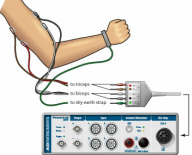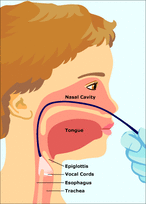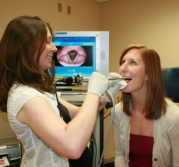Differential Diagnosis
Clinical features can help distinguish between the different types of SD. Adductor type SD (ADSD) is found in about 85 percent of diagnosed cases in the United States. The most common symptom associated with adductor type SD is a choked, strained-strangled voice with abrupt breaks in phonation in the middle of vowels. Breaks are due to hyper adduction of the vocal folds resulting in a quick glottic closure interrupting airflow through the glottis and interrupting phonation. Patients may experience difficulties with continually voiced sentences particularly when glottal stops mark word boundaries like “we_eat,” or when two voiced sounds occur in sequence within the word such as “ye_ar” or “d_og”. Examples of sentences patients may have a difficulty with include “We eat eels every day”, “We mow our lawn all year” and “A dog dug a new bone”. Abductor type SD (ABSD) is less common, found in approximately 15 percent of patients with SD. Patients usually exhibit a breathy, effortful voice with abrupt breaks resulting in whispered elements of their speech characterized by excessive and prolonged abduction during voiceless consonants (/h/,/s/,/f/,/p/,/t/,/k/). Vocal fold abduction interferes with closure of the vowel sound that follows. To examine for symptoms of abductor SD the patient’s speech should be compared during voiced sentences such as “We mow our lawn all year,” which should contain few abnormalities, with sentences containing a high proportion of voiceless consonants such as “The puppy bit the tape” and “When he comes home we’ll feed him”. If severe enough, the patient may display complete aphonia. Mixed type SD is extremely rare. Patients display symptoms of both adductor and abductor type SD. Diagnosis of a mixed disorder is important for predicting response to treatment. Diagnosis is similar to the diagnosis of either type of SD, with patients having difficulties with both types of tasks. Mixed patients are difficult to treat as Botulinum toxin can produce unwanted side effects with no benefit. Thyroarytenoid injection produces breathiness that exacerbates the disorder, while injection to the posterior cricoarytenoid muscle may provide little benefit.
Sources:
Revelo, O. (2009). Spasmodic dysphonia: Evaluation and management. Grand Rounds Presentation, UTMB, Dept. of Otolaryngology. Retrieved from http://www.utmb.edu/otoref/grnds/dysphonia-090310/dysphonia-090310.pdf
ASHA. (n.d.). Spasmodic dysphonia. Retrieved from http://www.asha.org/public/speech/disorders/spasmodicdysphonia/
Revelo, O. (2009). Spasmodic dysphonia: Evaluation and management. Grand Rounds Presentation, UTMB, Dept. of Otolaryngology. Retrieved from http://www.utmb.edu/otoref/grnds/dysphonia-090310/dysphonia-090310.pdf
ASHA. (n.d.). Spasmodic dysphonia. Retrieved from http://www.asha.org/public/speech/disorders/spasmodicdysphonia/



